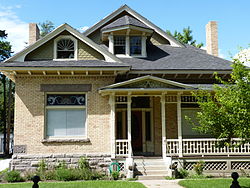- Charles E. Loose House
-
Charles E. Loose House
 Charles E. Loose House
Charles E. Loose HouseLocation: 383 E. Two Hundred South
Provo, UtahArea: less than one acre Built: 1893 Architectural style: Stick/Eastlake Governing body: Private MPS: Entreprenurial Residences of Turn-of-the-Century Provo TR NRHP Reference#: 82005114[1] Added to NRHP: July 23, 1982 The Charles E. Loose House is a historic house located in Provo, Utah. The house is listed on the National Register of Historic Places and is part of the Provo East Central Historic District.[1][2]
Contents
Charles E. Loose House * 383 East 200 South * Provo, Utah
Built in 1893 by Charles E. Loose, the Charles E. Loose House (383 E 200 S) "Combines the massing of the Shingle Style with a consistent program of Eastlake ornamentation. Its enveloping roof, veranda and pentagonal fanlight gable windows mark its individuality among the city's architectural sites (Historic Provo p. 24)." The Charles E. Loose House was designated a historic Provo City Landmark on April 28, 1995.
The Victorian Mansions of Provo
Built between the years 1893 and 1908 in Provo, Utah, this group of Victorian mansions are historically significant and represent not only fine architecture but some of the most successful men of the city and state at the time. These mansions include the Charles E. Loose House, the William H. Ray House, the Knight-Allen House, the John R. Twelves House, the Jesse Knight House, the Knight-Mangum House, and the Thomas N. Taylor House. All of these homes derive from the high style: Eastlake, Shingle, Craftsman, Italianate, Classical, Moorish, Colonial, and Romanesque Revivals. Made primarily of brick, these homes exhibit the finest architecture and most ornate detailing to be found in the city of Provo.
Charles E. Loose
Charles E. Loose (1853–1929) was a banker and a Utah State Senator. Charles was linked to Provo as a central entrepreneur during the period of time when Provo's economy transformed from primarily agrarian to that of commercial mining. Charles E. Loose was a non-Mormon, as opposed to many of the other primary entrepreneurs made wealthy by the tintic mining district, and probably the most prominent in Provo at the turn of the century. As Grand Central stock rose, so did Charles Loose. By 1900 the company had installed a new surface plant, including an innovative all steel headframe over its shaft—a first and only in the entire area. Thus, Loose built his Provo residence in 1893.
Jesse Knight and The Tintic Mining Industry
The successful commercial mining of precious metals and minerals transformed Utah's economy from basically an agrarian base to a more industrialized state. Within this development the Tintic Mining District, located approximately thirty miles southwest of Provo, was founded in 1869 and by 1899 became the leading mining center in Utah with a value of output placed at five million dollars. A central figure in Tintic success was Jesse Knight and the Knight family who resided in Provo. Jesse Knight attained wealth with his Humbug mine in the mid-1890s. The large silver producer allowed Knight to develop other mines in the East Tintic area. Knightsville grew around the workings and became touted as the only saloon-free, prostitute-free, privately owned mining camp in the U.S. His strict adherence to doctrines of the LDS church made the town one inhabited primarily by Mormons. Jessie Knight was able to expand farther than the tintic mines, reaching to the power plant in Santaquin, the Tintic drain tunnel project, the Knight Dry farm, and the smelters at Silver City. The Bonneville Mining company, the Knight Woolen Mills, Ellison Ranching Company, The American-Columbian Corporation, The Springville-Mapleton Sugar Company, The Spring Canyon Coal Company, Utah Savings Bank, The Layton Sugar Company, and the Tintic Drain Tunnel Company all represent facets of the Knight Investment Company. The success resulting from the Tintic Mining District provided the means for Charles E. Loose to acquire the wealth evident from his residence. In fact, Loose was involved in the Grand Central mining Company as a manager.
References
- ^ a b Utah County listings at the National Register of Historic Places . Retrieved 2011-08-05.
- ^ "Provo East Central Historic District Registration Form" (PDF). National Park Service. http://pdfhost.focus.nps.gov/docs/NRHP/Text/98000281.pdf. Retrieved 2011-08-05.
- Historic Provo. 2002 Provo City Landmarks Commission.
- Temme, Debbie/ Cannon, Ken/ Notarianni, Phil. National Register of Historic Places Inventory—Nomination Form. United States Department of the Interior Heritage Conservation and Recreation Service. Summer 1980.
External links
U.S. National Register of Historic Places Topics Lists by states Alabama • Alaska • Arizona • Arkansas • California • Colorado • Connecticut • Delaware • Florida • Georgia • Hawaii • Idaho • Illinois • Indiana • Iowa • Kansas • Kentucky • Louisiana • Maine • Maryland • Massachusetts • Michigan • Minnesota • Mississippi • Missouri • Montana • Nebraska • Nevada • New Hampshire • New Jersey • New Mexico • New York • North Carolina • North Dakota • Ohio • Oklahoma • Oregon • Pennsylvania • Rhode Island • South Carolina • South Dakota • Tennessee • Texas • Utah • Vermont • Virginia • Washington • West Virginia • Wisconsin • WyomingLists by territories Lists by associated states Other Categories:- Buildings and structures in Provo, Utah
- Houses completed in 1893
- Houses in Utah County, Utah
- Houses on the National Register of Historic Places in Utah
- Queen Anne architecture in Utah
- Shingle Style houses
Wikimedia Foundation. 2010.
